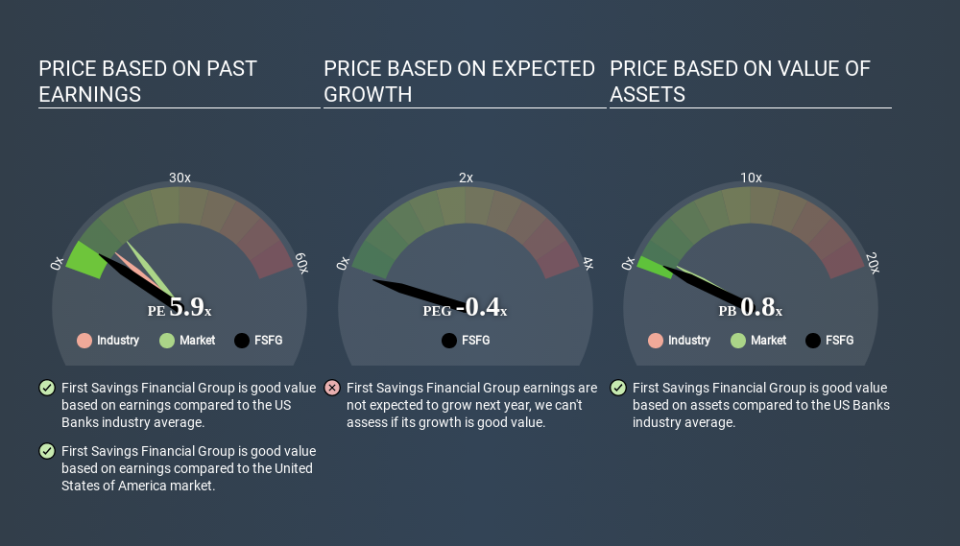What Is First Savings Financial Group's (NASDAQ:FSFG) P/E Ratio After Its Share Price Rocketed?

Those holding First Savings Financial Group (NASDAQ:FSFG) shares must be pleased that the share price has rebounded 32% in the last thirty days. But unfortunately, the stock is still down by 35% over a quarter. But shareholders may not all be feeling jubilant, since the share price is still down 23% in the last year.
All else being equal, a sharp share price increase should make a stock less attractive to potential investors. In the long term, share prices tend to follow earnings per share, but in the short term prices bounce around in response to short term factors (which are not always obvious). So some would prefer to hold off buying when there is a lot of optimism towards a stock. One way to gauge market expectations of a stock is to look at its Price to Earnings Ratio (PE Ratio). A high P/E implies that investors have high expectations of what a company can achieve compared to a company with a low P/E ratio.
Check out our latest analysis for First Savings Financial Group
Does First Savings Financial Group Have A Relatively High Or Low P/E For Its Industry?
We can tell from its P/E ratio of 5.90 that sentiment around First Savings Financial Group isn't particularly high. If you look at the image below, you can see First Savings Financial Group has a lower P/E than the average (8.9) in the banks industry classification.
This suggests that market participants think First Savings Financial Group will underperform other companies in its industry. Since the market seems unimpressed with First Savings Financial Group, it's quite possible it could surprise on the upside. If you consider the stock interesting, further research is recommended. For example, I often monitor director buying and selling.
How Growth Rates Impact P/E Ratios
Earnings growth rates have a big influence on P/E ratios. Earnings growth means that in the future the 'E' will be higher. Therefore, even if you pay a high multiple of earnings now, that multiple will become lower in the future. And as that P/E ratio drops, the company will look cheap, unless its share price increases.
In the last year, First Savings Financial Group grew EPS like Taylor Swift grew her fan base back in 2010; the 56% gain was both fast and well deserved. The sweetener is that the annual five year growth rate of 23% is also impressive. So I'd be surprised if the P/E ratio was not above average.
A Limitation: P/E Ratios Ignore Debt and Cash In The Bank
The 'Price' in P/E reflects the market capitalization of the company. So it won't reflect the advantage of cash, or disadvantage of debt. Hypothetically, a company could reduce its future P/E ratio by spending its cash (or taking on debt) to achieve higher earnings.
While growth expenditure doesn't always pay off, the point is that it is a good option to have; but one that the P/E ratio ignores.
So What Does First Savings Financial Group's Balance Sheet Tell Us?
Net debt totals a substantial 215% of First Savings Financial Group's market cap. This is a relatively high level of debt, so the stock probably deserves a relatively low P/E ratio. Keep that in mind when comparing it to other companies.
The Verdict On First Savings Financial Group's P/E Ratio
First Savings Financial Group has a P/E of 5.9. That's below the average in the US market, which is 13.6. The company has a meaningful amount of debt on the balance sheet, but that should not eclipse the solid earnings growth. If it continues to grow, then the current low P/E may prove to be unjustified. What we know for sure is that investors are becoming less uncomfortable about First Savings Financial Group's prospects, since they have pushed its P/E ratio from 4.5 to 5.9 over the last month. For those who like to invest in turnarounds, that might mean it's time to put the stock on a watchlist, or research it. But others might consider the opportunity to have passed.
Investors have an opportunity when market expectations about a stock are wrong. If it is underestimating a company, investors can make money by buying and holding the shares until the market corrects itself. So this free report on the analyst consensus forecasts could help you make a master move on this stock.
You might be able to find a better buy than First Savings Financial Group. If you want a selection of possible winners, check out this free list of interesting companies that trade on a P/E below 20 (but have proven they can grow earnings).
If you spot an error that warrants correction, please contact the editor at editorial-team@simplywallst.com. This article by Simply Wall St is general in nature. It does not constitute a recommendation to buy or sell any stock, and does not take account of your objectives, or your financial situation. Simply Wall St has no position in the stocks mentioned.
We aim to bring you long-term focused research analysis driven by fundamental data. Note that our analysis may not factor in the latest price-sensitive company announcements or qualitative material. Thank you for reading.

 Yahoo Movies
Yahoo Movies 

